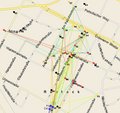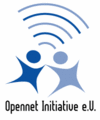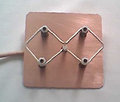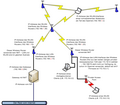Reise Djursland 2005: Unterschied zwischen den Versionen
(→Abrechnung: Roberts Kosten hinzu) |
(Livebericht Djursland rein) |
||
| Zeile 4: | Zeile 4: | ||
Diskussion im Forum: [http://forum.opennet-initiative.de/thread.php?threadid=332 http://forum.opennet-initiative.de/thread.php?threadid=332] <br/> | Diskussion im Forum: [http://forum.opennet-initiative.de/thread.php?threadid=332 http://forum.opennet-initiative.de/thread.php?threadid=332] <br/> | ||
Wetter: http://www.wetteronline.de/Daenemark/Arhus.htm | Wetter: http://www.wetteronline.de/Daenemark/Arhus.htm | ||
| + | |||
| + | == Livebericht === | ||
| + | |||
| + | '''Livebericht''' aus Djursland: | ||
| + | * Freitag - sind angekommen (19 Uhr), Talkrunde mit Frilandbewohnen, Netz mit OLSR aufgebaut (0:30), Bilder in der [http://www.opennet-initiative.de/gallery/ReiseDjursland2005 Djursland-Gallery] | ||
| + | * Samstag - 8 Uhr augestanden, mit Auto (mit altem Fritieroel betrieben) gefahren und im (eiskalten) See baden gewesen; 9 Uhr gemeinsames Frühstück mit ökologischen Produkten -- Philosophie-Talk mit Bjarkes; 11 Uhr Rundgang durchs Friland | ||
== Freitag == | == Freitag == | ||
Version vom 23. August 2005, 08:54 Uhr
Inhaltsverzeichnis |
Programm
Diskussion im Forum: http://forum.opennet-initiative.de/thread.php?threadid=332
Wetter: http://www.wetteronline.de/Daenemark/Arhus.htm
Livebericht =
Livebericht aus Djursland:
- Freitag - sind angekommen (19 Uhr), Talkrunde mit Frilandbewohnen, Netz mit OLSR aufgebaut (0:30), Bilder in der Djursland-Gallery
- Samstag - 8 Uhr augestanden, mit Auto (mit altem Fritieroel betrieben) gefahren und im (eiskalten) See baden gewesen; 9 Uhr gemeinsames Frühstück mit ökologischen Produkten -- Philosophie-Talk mit Bjarkes; 11 Uhr Rundgang durchs Friland
Freitag
Abreise: 14 Uhr CSR Center, im Bus
Late arrival
Treffen in Friland, an der Adresse: Econ Pavillonen, Friland 12, Feldballe, 8410 Ronde (N 56.28038 E010.58765).
Samstag
- Breakfeast at Fuglsoecentret
- Visit to the Europeia Science Center
- Short presentation of DjurslandsNet and the new Djursland Networking Project
- Drive to the headquarter at the eco-sustainable village Friland
- Lunch / picnic
- Guided trip through the world of DjurslandsNet
- Presentation of new EU project for 15 new Community Networks in the Balticum
- BBQ dinner at Friland and social event
Sonntag
- Breakfeast at Fuglsoecentret
- Short presentation of Rostock OpenNet
- Discussion and ideas session for further cooperation
- Ad-hoc
- Lunch
- Departure
Reisedetails
Anreise
Fahrtdauer mit dem Auto: 6 - 7 Stunden
Unterbringung
Variante 1: Camping
Friland Feldballe, Camping, free of cost, food costs 15 - 20 (Währung erfrage ich noch)
Variante 2: Fuglsoecentret
Kosten: 50 - 60 pro Person (Währung erfrage ich noch).
Organizer
Lokaler Organizer ist Gregers Petersen, den manche bereits von seinem Vortrag in Rostock kennen.
Seine Handy Nummer: +45 3024 8064
Abrechnung
| 247,00 EUR | Autoleih | Rene |
| ? EUR | Mehrkilometer Autoleih | Rene |
| 66,00 EUR | Tanken Dänemark | ? |
| ? EUR | Tanken Deutschland | ? |
| 140,00 EUR | Unterkunft | 100,- Ralph und 40,- Mathias |
| 56,64 EUR | Präsentkorb | Robert |
| 27,00 EUR | Sanddornprodukte | Robert |
Mitfahrer
- Clemens Cap
- Robert Nickel
- Ralph Oesker
- Sebastian Hagen
- Mathias Mahnke
- Rene Ejury
- Friedrich Hartmann
Fahrt per gemeinsamen Mietwagen. Unterbringung im Friland. Zelten frei möglich
Vortrag
Endversion als Powerpoint Präsentation bei Clemens Cap.
Gliederung
- introduction: Original motivation and project history
- technology
- officially supported Access Points - Linksys WRT54g and Asus WL-500g
- IEEE80.211 compliant WIFI (ad-hoc mode), IPv4, OLSR
- node types
- stationary nodes
- antennas placed on the roof
- APs placed inside flats or offices
- to maintain an effective infrastructure, the association owns and administers APs at some important locations
- mobile nodes
- basically just notebooks with wifi-cards that run OLSR
- usable anywhere in the area serviced by ON
- stationary nodes
- history of infrastructure development
- temporary installations for test purposes
- point-to-point connections using highly directional antennas
- growth; mixed use of directional antennas and omnidirectional antennas placed inside of buildings
- tendency of members to attempt to establish direct wifi-links to APs linked by LAN to an internet-gateway, stagnation
- growth and increase of redundant routes through increase in AP density and use of less directional antennas
- history of transmission protocols
- WDS; bridging; ethernet Spanning Tree Protocol to deactivate redundant routes
- ad-hoc mode; IPv4 routing; OLSR
- address spaces
- gateway "titan"
- SNAT Opennet -> Internet
- OpenVPN 2.0; authentication through certificates signed by our CA
- DNAT (i.e. port forwarding) to openvpn Addresses; currently 10 ports per user
- DSL; theoretical bandwith 3000/384 (kbit/s)?
- logging of individual connections
- Ocellata - Connection Quality; measured by using ICMP ECHO Requests
- Crinoidea (MySQLdb) - topN IP Addresses according to ON-Internet traffic caused
- Alfredi (PIM) - Maps with colored nodes and connections
- Ketupo (olsrd, olsrd_dd_ti, dot, Pydot) - Topology Dot Graphs
- Teucrium (netfilter, rrdtool, pyrddtool) - Traffic Graphs
- interfaces for users
- ethernet on their own AP
- possibility of using a second AP for private wireless use
- OpenVPN for internet-routing (endpoints on user-APs or client-systems)
- ethernet on their own AP
- Acccess Point Firmware
- started out using Sveasoft's Alchemy on Linksys, default FW on Asus APs
- current versions based on OpenWRT
- legacy ON FW: based on Freifunk-Firmware 1.0.2, minor modifications
- "Opennet Firmware" based on OpenWRT whiterussian (currently rc2) (several modifications, including the FFF-webinterface)
- web-based installation and configuration possible
- OpenVPN use on the AP explicitly supported; automated certificate creation
- individual extensions still possible, of course
- social issues
- general structure
- loosely organized, no pervasive hierarchical structure
- high importance of technologically skilled members
- day-to-day operation
- workshoops and meetings - also effective ways for interested persons to get involved
- documentation (e.g. HOWTOs) is collaboratively maintained on the ON wiki
- communication mostly per Forum, IRC and e-mail
- increasing interest in public relations issues
- motivation for individual members
- cheap internet access
- relatively fast internet access compared to the alternatives in areas without DSL coverage
- interest in technology / the community / ideological issues
- mobile internet access in the covered area
- general structure
- organisation
- some explicit internal rules
- responsibility for most of the infrastructure lies with AP-owners (i.e. individual members)
- individual competent members responsible for
- firmware design
- gateway administration
- management of jointly owned APs
- Public Relations
- support of new members
- future relevance
- connecting villages without broadband-coverage?
- supported by people interested in technological and social issues in areas covered by broadband
- mobile use
- guesstimated use of communication methods
- 45% - Forum (Wortlab Burning Board)
- 30% - Wiki (Mediawiki)
- 15% - Opennet IRC, increasing relevance
- 6% - Opennet mailing list (Mailman)
- 3% - Opennet Mail (apXX@..)
- 1% - Gallery
Wichtige Bilder
Weitere Bilder:















